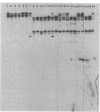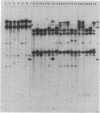Abstract
DNAs extracted from peripheral blood leukocytes of 24 individuals, selected for their HLA-DR types, -DR2, -DR5, and -DRw6, were analyzed with four restriction enzymes, BamHI, EcoRV, HindIII, and Taq I, using the Southern technique. This panel includes 16 individuals with homozygous typing cells and 8 heterozygous individuals who carry rare Dw subtypes or unusual DR-DQ associations. Eighty-five polymorphic fragments were detected and assigned to the DR or DQ gene families according to their hybridization signals. Thirty-eight fragments (DR or DQ) were found to correlate with single DR or Dw specificities or rare associations such as DRw14-DQw3. Forty-two fragments correlated with the association of immunologically defined specificities. In total, these 85 fragments constituted 44 different patterns, each comprising 1-9 fragments. For each homozygous typing cell a combination of patterns was observed. Fourteen different combinations of 10-20 patterns were found among the 16 individuals with homozygous typing cells, showing that Dw18, Dw19, Dw9, and Dw5 are heterogeneous at the genomic level whereas only the Dw2 individuals tested here are identical.
Full text
PDF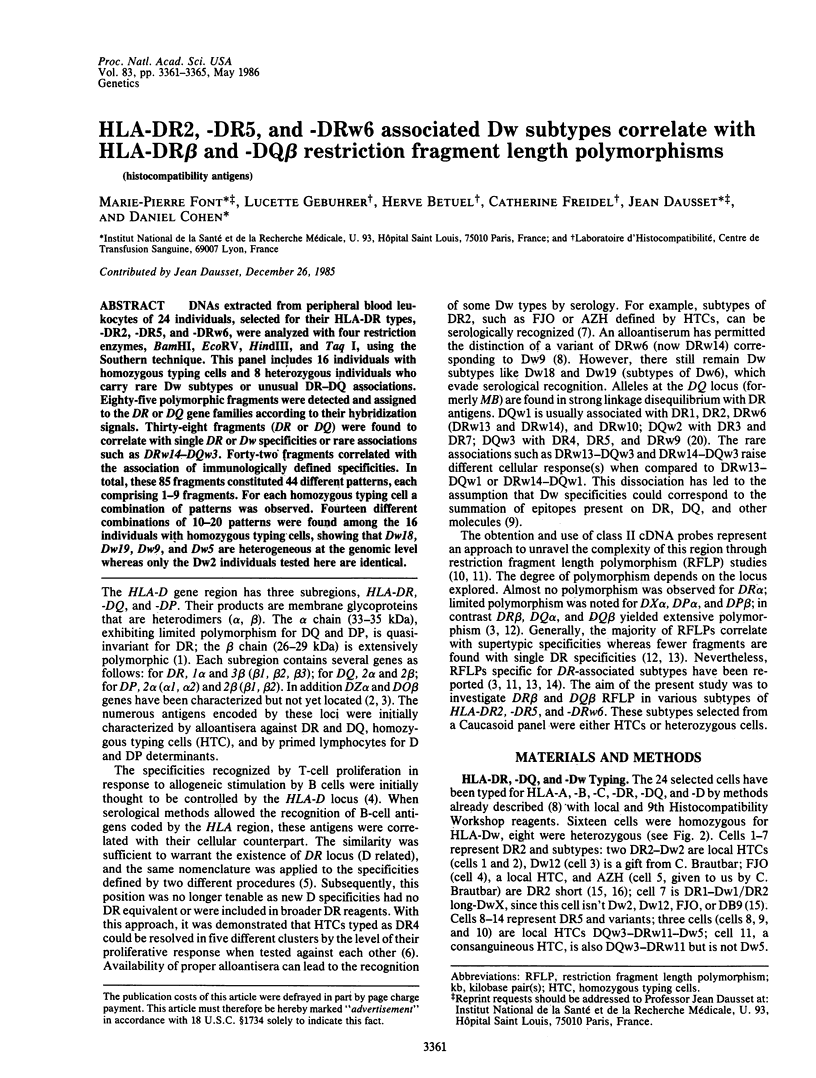
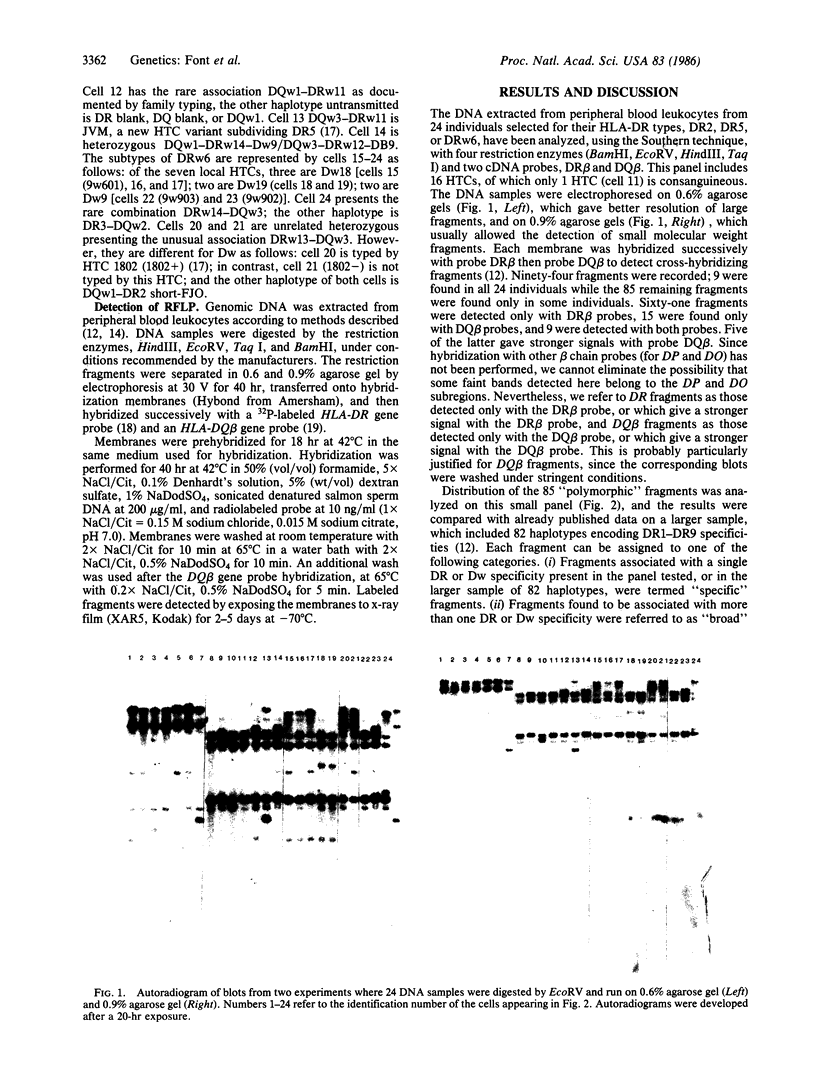
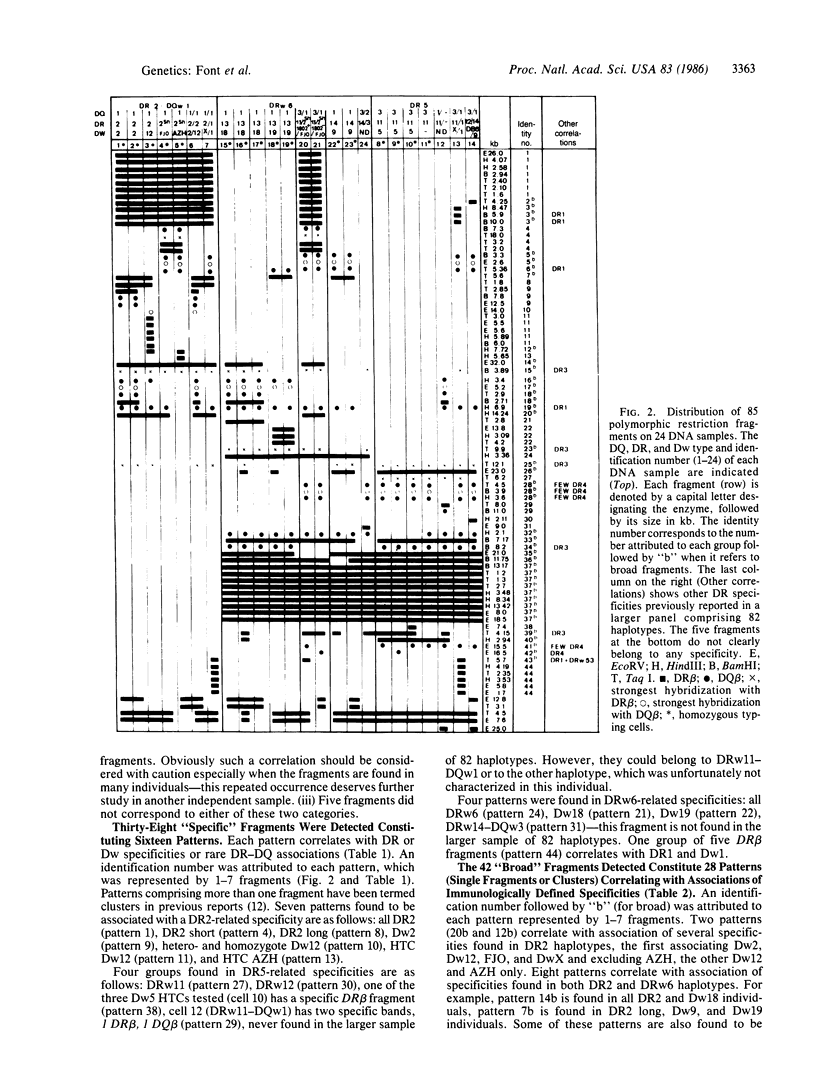
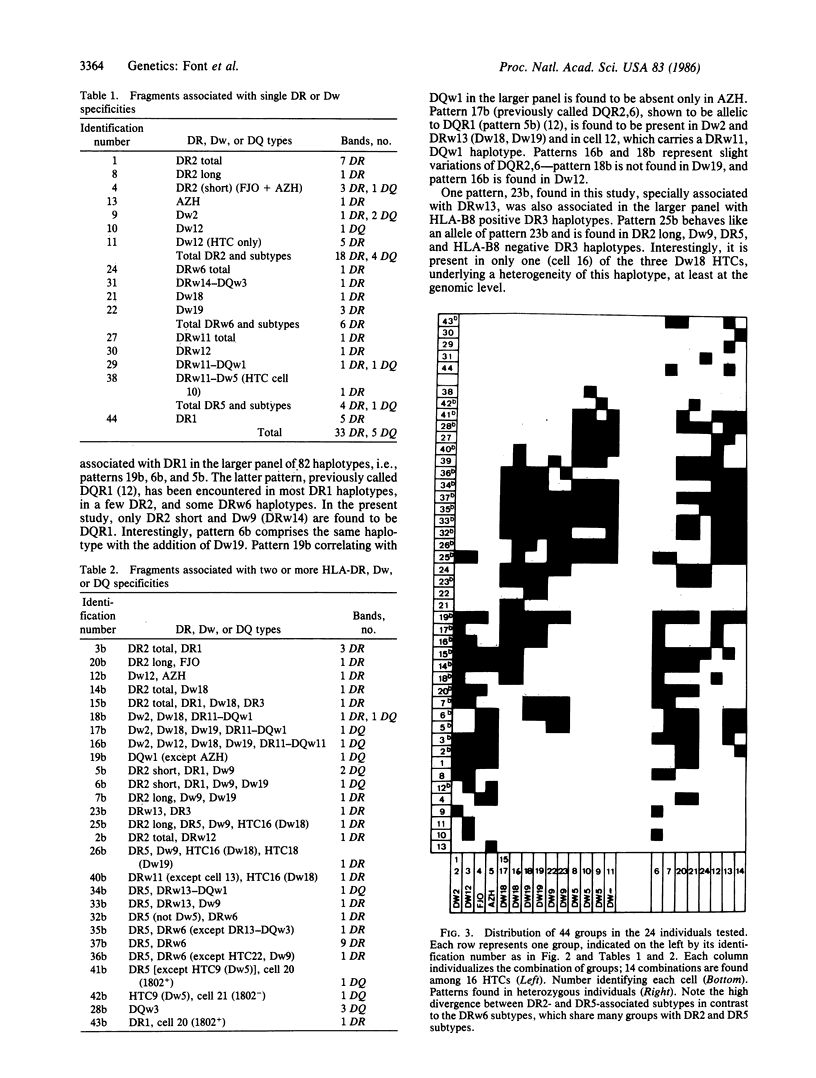
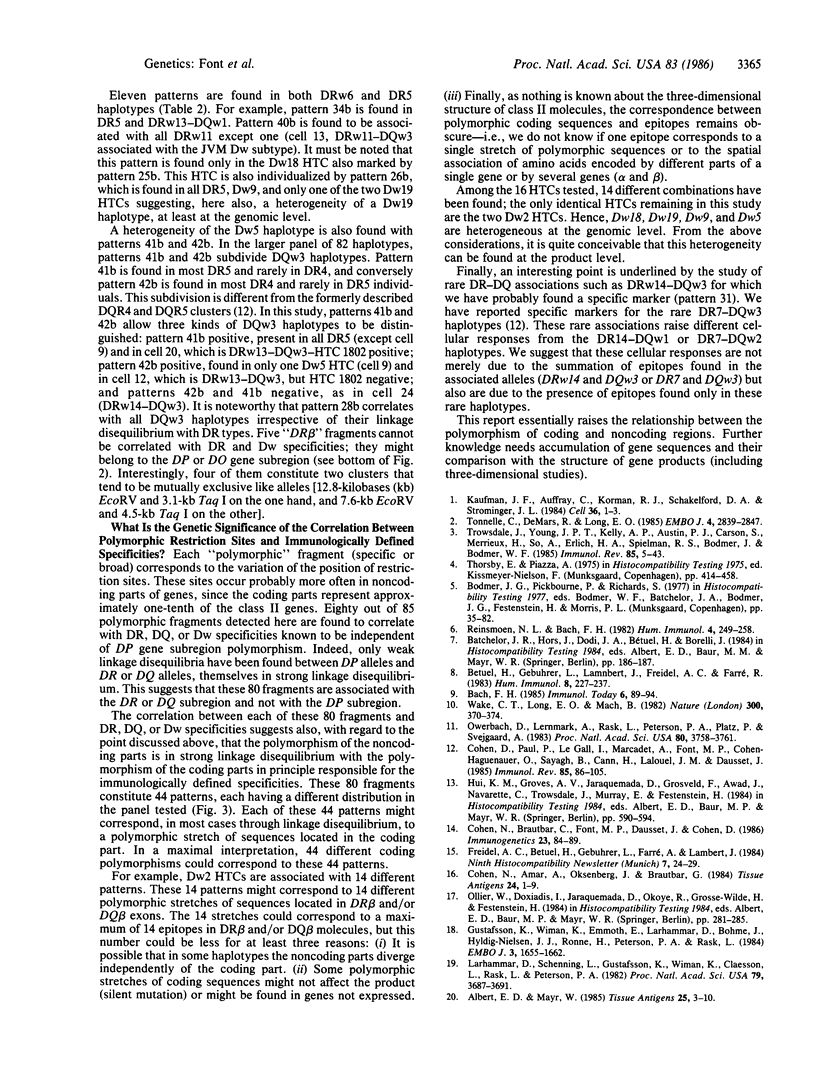
Images in this article
Selected References
These references are in PubMed. This may not be the complete list of references from this article.
- Albert E., Mayr W. Brief summary of Ninth International Histocompatibility Workshop. Tissue Antigens. 1985 Jan;25(1):3–10. doi: 10.1111/j.1399-0039.1985.tb00405.x. [DOI] [PubMed] [Google Scholar]
- Betuel H., Gebuhrer L., Lambert J., Freidel A. C., Farre A. A possible new HLA-DR allele. Hum Immunol. 1983 Nov;8(3):227–237. doi: 10.1016/0198-8859(83)90040-x. [DOI] [PubMed] [Google Scholar]
- Cohen D., Paul P., Le Gall I., Marcadet A., Font M. P., Cohen-Haguenauer O., Sayagh B., Cann H., Lalouel J. M., Dausset J. DNA polymorphism of HLA class I and class II regions. Immunol Rev. 1985 Jul;85:87–105. doi: 10.1111/j.1600-065x.1985.tb01131.x. [DOI] [PubMed] [Google Scholar]
- Cohen N., Amar A., Oksenberg J. R., Brautbar C. HLA-D clusters associated with DR2 and the definition of HLA-D"AZH": a new DR2 related HLA-D specificity in Israel. Tissue Antigens. 1984 Jul;24(1):1–9. doi: 10.1111/j.1399-0039.1984.tb00390.x. [DOI] [PubMed] [Google Scholar]
- Cohen N., Brautbar C., Font M. P., Dausset J., Cohen D. HLA-DR2-associated Dw subtypes correlate with RFLP clusters: most DR2 IDDM patients belong to one of these clusters. Immunogenetics. 1986;23(2):84–89. doi: 10.1007/BF00377966. [DOI] [PubMed] [Google Scholar]
- Gustafsson K., Wiman K., Emmoth E., Larhammar D., Böhme J., Hyldig-Nielsen J. J., Ronne H., Peterson P. A., Rask L. Mutations and selection in the generation of class II histocompatibility antigen polymorphism. EMBO J. 1984 Jul;3(7):1655–1661. doi: 10.1002/j.1460-2075.1984.tb02026.x. [DOI] [PMC free article] [PubMed] [Google Scholar]
- Kaufman J. F., Auffray C., Korman A. J., Shackelford D. A., Strominger J. The class II molecules of the human and murine major histocompatibility complex. Cell. 1984 Jan;36(1):1–13. doi: 10.1016/0092-8674(84)90068-0. [DOI] [PubMed] [Google Scholar]
- Larhammar D., Schenning L., Gustafsson K., Wiman K., Claesson L., Rask L., Peterson P. A. Complete amino acid sequence of an HLA-DR antigen-like beta chain as predicted from the nucleotide sequence: similarities with immunoglobulins and HLA-A, -B, and -C antigens. Proc Natl Acad Sci U S A. 1982 Jun;79(12):3687–3691. doi: 10.1073/pnas.79.12.3687. [DOI] [PMC free article] [PubMed] [Google Scholar]
- Owerbach D., Lernmark A., Rask L., Peterson P. A., Platz P., Svejgaard A. Detection of HLA-D/DR-related DNA polymorphism in HLA-D homozygous typing cells. Proc Natl Acad Sci U S A. 1983 Jun;80(12):3758–3761. doi: 10.1073/pnas.80.12.3758. [DOI] [PMC free article] [PubMed] [Google Scholar]
- Reinsmoen N. L., Bach F. H. Five HLA-D clusters associated with HLA-DR4. Hum Immunol. 1982 Jun;4(3):249–258. doi: 10.1016/0198-8859(82)90040-4. [DOI] [PubMed] [Google Scholar]
- Tonnelle C., DeMars R., Long E. O. DO beta: a new beta chain gene in HLA-D with a distinct regulation of expression. EMBO J. 1985 Nov;4(11):2839–2847. doi: 10.1002/j.1460-2075.1985.tb04012.x. [DOI] [PMC free article] [PubMed] [Google Scholar]
- Trowsdale J., Young J. A., Kelly A. P., Austin P. J., Carson S., Meunier H., So A., Erlich H. A., Spielman R. S., Bodmer J. Structure, sequence and polymorphism in the HLA-D region. Immunol Rev. 1985 Jul;85:5–43. doi: 10.1111/j.1600-065x.1985.tb01129.x. [DOI] [PubMed] [Google Scholar]
- Wake C. T., Long E. O., Mach B. Allelic polymorphism and complexity of the genes for HLA-DR beta-chains--direct analysis by DNA-DNA hybridization. Nature. 1982 Nov 25;300(5890):372–374. doi: 10.1038/300372a0. [DOI] [PubMed] [Google Scholar]



